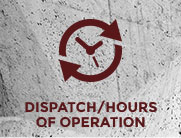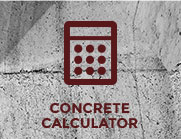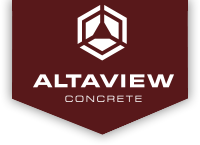THE PERFECT POUR
- Site Preparation
- Screeding
- Bull Floating
- Edging
- Joints
- Hand Troweling
- Brooming
- Curing and Sealing
PLACING AND FINISHING TOOLS
- Form release oil
- Construction-size wheel barrow
- Square-ended shovels
- Come-along or concrete rake
- Screed board (or straight 2×4 a couple of feet longer than the width of your pour)
- Bullfloat or darby (with long enough handles)
- Hand float
- Margin trowel
- Kneeboards
- Edger
SITE PREPARATION
 Site Preparation is one of the most important aspects of obtaining a quality concrete job that will last. It is imperative that the sub-base be sound, compacted, and level. Soft spots, high points, loose dirt, grass, and existing concrete must be eliminated before concrete can be poured. If the desired area for your pad is water logged or has poor base quality, you must excavate down a minimum of four (4) inches below the bottom grade of the concrete, and replace the removed area with a road base material suitable for proper compaction. Poor quality gravel, dirt or large rocks are not recommended as a proper base. There are situations and conditions that require deeper base material, as well as a deeper or thicker concrete pad or wall, and such should be examined and reviewed by a professional contractor. If you have any concerns or unanswered questions, please contact our Sales Department or Dispatch.
Site Preparation is one of the most important aspects of obtaining a quality concrete job that will last. It is imperative that the sub-base be sound, compacted, and level. Soft spots, high points, loose dirt, grass, and existing concrete must be eliminated before concrete can be poured. If the desired area for your pad is water logged or has poor base quality, you must excavate down a minimum of four (4) inches below the bottom grade of the concrete, and replace the removed area with a road base material suitable for proper compaction. Poor quality gravel, dirt or large rocks are not recommended as a proper base. There are situations and conditions that require deeper base material, as well as a deeper or thicker concrete pad or wall, and such should be examined and reviewed by a professional contractor. If you have any concerns or unanswered questions, please contact our Sales Department or Dispatch.
SCREEDING
 Screeding is the key to producing a true flat surface. It removes excess concrete and brings the top surface to proper grade. Use a piece of 2×4 lumber specially selected for its’ straightness. The straight edge should be 1 to 2 feet longer than the slab is wide so that it is always resting on a form on each side. To “screed level” the slab you pull the straight edge forward in a side-to-side sawing motion across the tops of the side forms. At the same time, tilt the top of the straight edge slightly away from the direction of travel. The sawing motion helps prevent tearing of the concrete surface and produces a relatively smooth and level surface. Tilting the straight edge produces a single cutting edge. To fill in low spots, keep a roll of concrete about an inch high ahead of the straight edge at all times. When you reach the end of the slab, pull excess concrete into, not away from the end edge forms.
Screeding is the key to producing a true flat surface. It removes excess concrete and brings the top surface to proper grade. Use a piece of 2×4 lumber specially selected for its’ straightness. The straight edge should be 1 to 2 feet longer than the slab is wide so that it is always resting on a form on each side. To “screed level” the slab you pull the straight edge forward in a side-to-side sawing motion across the tops of the side forms. At the same time, tilt the top of the straight edge slightly away from the direction of travel. The sawing motion helps prevent tearing of the concrete surface and produces a relatively smooth and level surface. Tilting the straight edge produces a single cutting edge. To fill in low spots, keep a roll of concrete about an inch high ahead of the straight edge at all times. When you reach the end of the slab, pull excess concrete into, not away from the end edge forms.
BULL FLOATING
 Bull floats are used to level ridges and fill in low spots left by “screeding”. They also slightly embed the large aggregate particles and work up a slight amount of paste or cream on the surface to facilitate later finishing operations. Start bull floating immediately after screeding. Pass the bull float across the slab perpendicular to the direction that the straight edge is pulled. Push the blade ahead, while holding the handle low and raising the front edge slightly. This keeps the float from digging into the concrete surface. Then pull the float back similarly, holding the back edge of the blade slightly raised to level the high spots and fill voids.
Bull floats are used to level ridges and fill in low spots left by “screeding”. They also slightly embed the large aggregate particles and work up a slight amount of paste or cream on the surface to facilitate later finishing operations. Start bull floating immediately after screeding. Pass the bull float across the slab perpendicular to the direction that the straight edge is pulled. Push the blade ahead, while holding the handle low and raising the front edge slightly. This keeps the float from digging into the concrete surface. Then pull the float back similarly, holding the back edge of the blade slightly raised to level the high spots and fill voids.
EDGING
 Edging compacts the concrete next to the form where floating and troweling are less effective. This makes the edge of the slab more durable and less likely to scale and chip. Hold the edging tool flat on the concrete surface and run it in a forward and backward motion. Keep the front or leading edge of the edging tool slightly raised in the forward direction and the back slightly raised in the backward direction. Do not start edging in a corner and don’t raise the edges of the concrete unless the tool is in motion. Be careful not to leave an impression in the fresh concrete that is so deep it’s difficult to remove in later finishing operations.
Edging compacts the concrete next to the form where floating and troweling are less effective. This makes the edge of the slab more durable and less likely to scale and chip. Hold the edging tool flat on the concrete surface and run it in a forward and backward motion. Keep the front or leading edge of the edging tool slightly raised in the forward direction and the back slightly raised in the backward direction. Do not start edging in a corner and don’t raise the edges of the concrete unless the tool is in motion. Be careful not to leave an impression in the fresh concrete that is so deep it’s difficult to remove in later finishing operations.
JOINTS
 Concrete will nearly always crack due to shrinkage after the water evaporates and is absorbed into the cement powder, so it is imperative that you put in marks or cuts to control where the concrete will crack. Joints or cuts are put into the fresh concrete with a marking tool for the purpose of “telling” the concrete where you want it to crack. Marking tools can be rented at most rental yards, and come with eight foot length poles for reaching across a fresh concrete pad. To determine where the marks are to be made, it is a general rule that the marks must not exceed eight to ten feet apart in a four inch thick pad. Use a snap line to pre-mark your marking tool path and always run a joint off corners of buildings or steps.
Concrete will nearly always crack due to shrinkage after the water evaporates and is absorbed into the cement powder, so it is imperative that you put in marks or cuts to control where the concrete will crack. Joints or cuts are put into the fresh concrete with a marking tool for the purpose of “telling” the concrete where you want it to crack. Marking tools can be rented at most rental yards, and come with eight foot length poles for reaching across a fresh concrete pad. To determine where the marks are to be made, it is a general rule that the marks must not exceed eight to ten feet apart in a four inch thick pad. Use a snap line to pre-mark your marking tool path and always run a joint off corners of buildings or steps.








